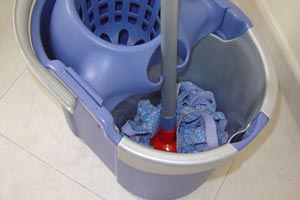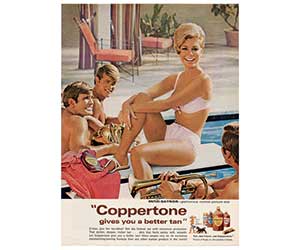
Flickr/<a href="http://www.flickr.com/photos/boynton/">Lucy Boynton</a>
I could really use some better sunscreen. Red-headed, freckled, and ridiculously pale (think: a few shades lighter than your average slice of Wonder Bread), I burn at the slightest suggestion of a sunny day, even though I religiously slather on the SPF one-bazillion goop. Last year, I wrote a piece for Mother Jones about how sunscreen manufacturers’ claims (All day protection! Sweat proof! SPF through the roof!) rarely measure up to the products’ performance. So when I heard that the Environmental Working Group was releasing its 2010 list of best and worst sunscreens, I had hope: Would this be the year sunscreen manufacturers finally figured out how to save me from turning into a Twizzler after 10 minutes of yard work?
You’d think so, since according to the new report, 1 in 6 sunscreens is now labeled with an SPF of above 50, compared to 1 in 8 last year. Sounds like good news, since higher SPF means more protection, right? Not really, says EWG senior analyst Sean Gray. The difference between an SPF 50 product and and SPF 110 product is minuscule. Gray believes the sky-high SPF labels can actually be dangerous. “We have studies that show that people who use the higher SPF products don’t reapply it,” says Gray. “So they end up with more UV exposure overall.” (Mother Jones reported on this phenomenon back in the day.)
Another scary new finding: There is preliminary evidence from a recent FDA animal study that a form of vitamin A called retinyl palmitate, present in about 40 percent of sunscreens, may accelerate the development of skin cancer. Researchers applied sunscreens containing retinyl palmitate to one group of hairless mice and sunscreens without the additive to another group. When exposed to UV radiation, the retinyl palmitate group developed lesions and tumors significantly faster than than the non-retinyl palmitate group. What’s frightening is that people see “vitamin” and “think it’s good for them,” says Gray.
So which sunscreens are best? EWG says so-called “mineral blockers,” which generally use nanoparticles of zinc or titanium oxide to block UV light, are safer than “chemical blockers,” since they protect against both UVA and UVB rays (UVB cause burns, but UVA rays have been linked to skin cancer) and don’t become unstable in sunlight. Are nanoparticles completely safe? “All the research we’ve looked at suggests they don’t penetrate the skin, but there is still debate about that,” says Gray. If you do choose a chemical blocker, choose one with avobenzone, which protects against both UVA and UVB rays. Stay away from oxybenzone, which only filters out UVB light, and could also disrupt hormonal function.
The bright side: The FDA expects to debut its long-awaited new sunscreen labeling system—which will require manufacturers to include information about both UVA and UVB protection and ban claims of SPFs higher than 50—this coming October.
Here’s a list of EWG’s best and worst sunscreens of 2010:
EWG’s 8 “Hall of Shame” Sunscreens (in no particular order):
1. Banana Boat MAX Protect & Play Baby Lotion SPF 100
Why: Despite high SPF value, offers poor UVA protection.
2. iS Clinical SPF 20 Powder Sunscreen & Peter Thomas Roth Instant Mineral SPF 30
Why: “Loose powder sunscreens can enter the airways and may move from the lungs to the bloodstream.”
3. Hawaiian Tropic SPF 50 Baby Creme Lotion
Why: Despite its claim of “advanced UVA protection,” EWG’s research shows it’s a poor UVA blocker.
4. Aveeno Baby Continuous Protection Sunblock Lotion SPF 55
Why: “Mild as water” claim is misleading.
5. Anthony Logistics for Men Sun Stick SPF 15
Why: “This product’s directions tell users to ‘Apply to eye area,’ but the warnings advise: ‘Keep out of eyes.'”
6. Panama Jack Naturals Baby Sunblock SPF 50
Why: Contains oxybenzone, a suspected hormone disruptor.
7. Banana Boat Ultra Defense Sunscreen SPF 50 Stick
Why: Label claims, “It doesn’t break down,” but, like all sunscreens, it still needs to be reapplied regularly.
8. Baby Blanket Tender Scalps Spray SPF 45+
Why: Poor UVA protection.
Best Sunscreens (these products scored a 1, the best score EWG issues):
Badger
SPF 30 Unscented Natural Sunscreen
SPF 30 for Face and Body
California Baby
No Fragrance SPF 30+ Sunblock Stick
Loving Naturals
Sunscreen, SPF 30+
Purple Prairie Botanicals
Sun Stuff SPF 30 Lotion
Sun Stick SPF 30
Soleo Organics
All Natural Sunscreen, SPF 30+
Soleo Organics/Wyland Organics All Natural Sunscreen, SPF 30+
Soleo Organics/Atlantis Resort All Natural Sunscreen, SPF 30+
thinkbaby and thinksport
Safe Sunscreen, SPF 30+
UVNatural
Baby Sunscreen, SPF 30+
Sport Sunscreen, SPF 30+
Best chemical-blocker sunscreens:
Beyond Coastal
Active SPF 30 Sunscreen
Daily SPF 15 Sunscreen
BullFrog
Ultimate Sheer Protection FACE, SPF 30
Ultimate Sheer Protection, SPF 30
Coppertone
ultraGUARD Sunscreen Lotion, SPF 15
Oil-Free Lotion SPF 15
Sport Sunblock Lotion, SPF 15
Glytone
Sunscreen Lotion, SPF 25
La Roche-Posay
Anthelios 15 Sunscreen, SPF 15
For the full scoop, including the conflicting research on whether sunscreen prevents us from getting the vitamin D we need, Europe’s better UVA-blocking ingredients, and the full list of sunscreens evaluated and their ratings, check out EWG’s full 2010 report. For more tips on sunscreen (How often should you reapply? How long should you keep a bottle of sunscreen around before it expires?) read “Sunscreen’s Shady Claims.”
Got a burning question? Submit your environmental dilemmas to econundrums@motherjones.com. Get all your green questions answered by signing up for our weekly Econundrums newsletter here.
















